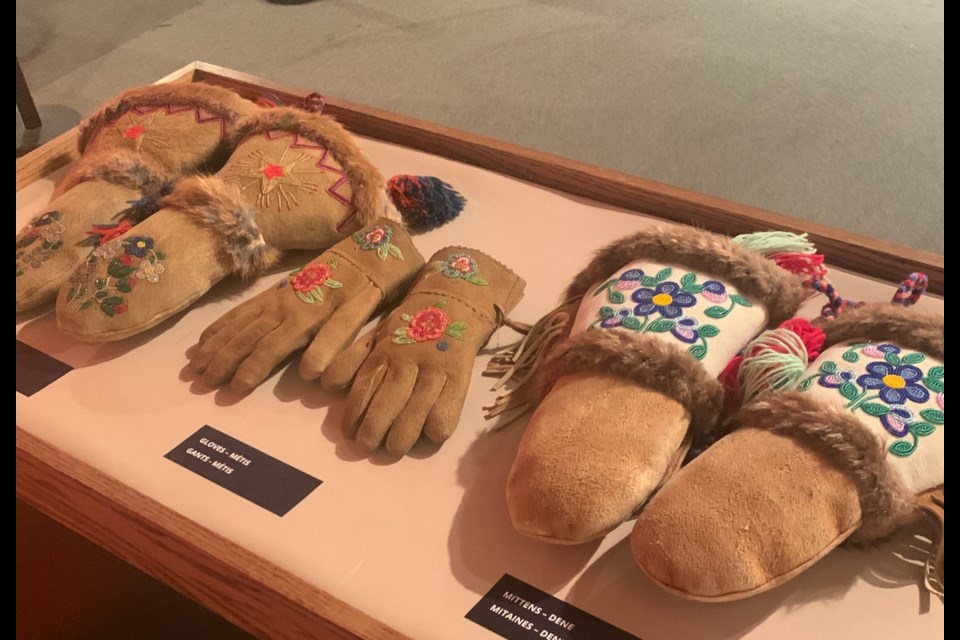For as long as people have lived across Alberta’s prairie landscape, they’ve had to dress for bitter cold winters.
About 150 years ago, when the province was peopled by First Nations, Métis and early settlers, there were no thermal socks, down-filled parkas or battery-powered boots. So, what did people in the St. Albert area wear for protection against winter’s icy blasts?
Warm and Woolly, Musée Heritage Museum’s current exhibition, explores how First Nations, Métis and settlers used various textiles to cope with freezing temperatures. Martin Bierens, museum curator, has dug up old photos from archives dating from the mid 1800s and beyond to tell a story that encompasses textiles, artisans, the fur trade, agriculture and politics.
We see our province’s history through the evolution of different textiles from furs and buffalo robes to wool and blended fibres. It also includes gripping tidbits of Alberta’s historic fight for grazing rights between cattle and sheep ranchers.
When Bierens started planning the exhibition, his original vision was to focus on winter attire within St. Albert and how people lived.
“But as I began to do research, the use of different textiles grabbed my attention, and how wool was the first industry to start up in Alberta and the first to fail,” said Bierens.
Prior to European arrivals and the installation of the Hudson Bay fur trade, Nehiyaw (Cree) and other Plains First Nations people wore buffalo robes because of its superior warmth and durability.
In one of the panels Bierens created, he states once the Métis fur trade was installed across Alberta, a new fashion overtook the prairies in the form of capotes. Capotes were a thigh-length wool coat made exclusively from a red, black, yellow and white striped Hudson Bay blanket.
Protected by a glass showcase, one of the most impressive articles of clothing featured at the exhibition is a traditional hooded capote. Borrowed from Royal Alberta Museum, Bierens describes it as “completely a Métis invention. It’s all hand-stitched and is the winter uniform for fur traders.”
Another stunning example of winter outerwear is a mid-thigh buffalo fur coat the RCMP wore from 1931 to 1945. It was modelled on the traditional Northwest Mounted Police uniform dating from 1870 to 1900.
“It was worn because it afforded such excellent warmth. They were phased out because they severely decreased mobility. They were switched to wool because it was easier to wear,” Bierens said. He estimated a dry bison coat weighed more than 10 pounds.
Wool was lighter and easier to clean, providing greater consumer appeal. One of the busiest woollen mills in Alberta was the Golden Fleece Woollen Mill in Magrath which produced 3,200 blankets monthly and used over one million pounds of wool each year, much of it which came from Alberta.
During the Second World War it produced more than 18,000 blankets for the federal government, but in 1945 the company sold its operation. Despite its success during the war, Golden Fleece noticed the price of wool had dropped, sheep ranchers were switching herds to higher-paying meat-producing breeds and many ranchers were shipping wool east to established mills.
St. Albert Mission was one of the first areas in Alberta to raise sheep for wool. In 1881, the mission bought a small flock of 36 sheep. Three years later, the flock had grown to 125 head.
Sheep were an attractive addition to homesteaders who benefited from the high-quality wool and meat for the family. Many settlers operated a mixed farm and the Gagnon family kept a few sheep for a supply of wool to make socks and other personal items.
Laura Marie Doherty (nee Gagnon) provided a quote to the exhibit saying, “We girls knitted socks, toques, scarves, mitts, gloves and long panties for winter, as we had almost two miles to walk to school.”
In addition to the cold, many First Nations and Métis people faced starvation and disease. In a period of about eight years, buffalo gradually disappeared, while successive crop failures due to poor weather and the smallpox epidemic wiped out one-third of St. Albert’s Mission population. By 1888 three chiefs including Michel Callihoo spoke out through the Edmonton Bulletin stating the government was not fulfilling its treaty obligations in providing rations.
However, winter was not all bad. Births, weddings, family events, dances, hockey games and skating parties were a welcome relief from below-zero temperatures. And despite the cold weather, most people thrived.
Two legendary St. Albert distinguished athletes who achieved international success and are highlighted in the winter-sports section are Hec Gervais, the 1961 World Champion Curler and Joe Benoit, who in the 1940s was Canada’s first Métis hockey player to win the Stanley Cup playing for the Montreal Canadiens.
“We didn’t just want to talk about the dark part of winter. We also wanted to talk about the joys that come with winter sports in this part of the world. Hec Gervais and his father were involved in founding St. Albert’s first curling rink and they took care of it. And Joe Benoit played in the juniors as part of the Trail Smoke Eaters and then played four full seasons with Montreal,” said Bierens.
“I hope the public will come and find moments appropriate to winter – the joys and also the hardships winter brought to St. Albert. And I hope people will appreciate how much easier it is with modern technology.”
Warm and Woolly runs until Feb. 22, 2025. The exhibition reception is Saturday, Oct. 26, at 2 p.m., and Shannon Nelson of Edmonton's Traceable Textiles will give a talk on the current Alberta textile industry. The event is free.


.png;w=120;h=110;mode=crop)

